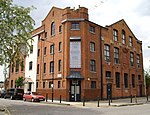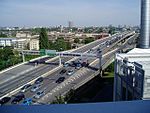Latimer Road tube station
Circle line stationsFormer Hammersmith and City Railway stationsHammersmith & City line stationsLondon stations without latest usage statistics 1415London stations without latest usage statistics 1516 ... and 9 more
London stations without latest usage statistics 1617London stations without latest usage statistics 1718London stations without latest usage statistics 1819London stations without latest usage statistics 1920London stations without latest usage statistics 2021Rail transport stations in London fare zone 2Railway stations in Great Britain opened in 1868Tube stations in the Royal Borough of Kensington and ChelseaUse British English from August 2012

Latimer Road is a London Underground station in North Kensington, in the Royal Borough of Kensington and Chelsea. It is on the Circle and Hammersmith & City lines between Wood Lane and Ladbroke Grove stations and is in Travelcard Zone 2.
Excerpt from the Wikipedia article Latimer Road tube station (License: CC BY-SA 3.0, Authors, Images).Latimer Road tube station
Station Walk, London North Kensington (Royal Borough of Kensington and Chelsea)
Geographical coordinates (GPS) Address Nearby Places Show on map
Geographical coordinates (GPS)
| Latitude | Longitude |
|---|---|
| N 51.514 ° | E -0.217 ° |
Address
Grenfell Walk
Station Walk
W10 6SZ London, North Kensington (Royal Borough of Kensington and Chelsea)
England, United Kingdom
Open on Google Maps






